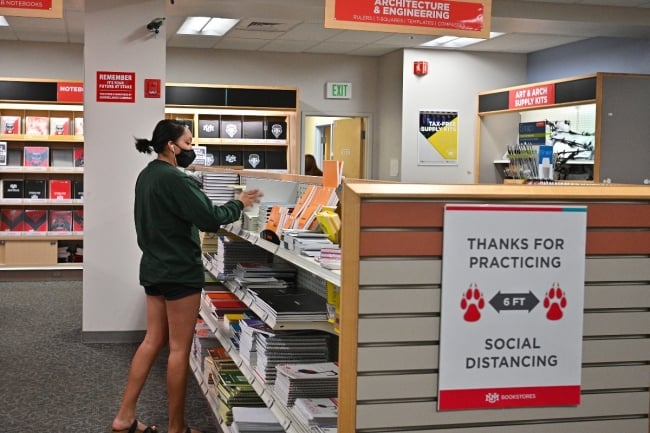You have /5 articles left.
Sign up for a free account or log in.

Sam Wasson/Getty Images
Ella Meloy was tired of getting hit with hefty textbook fees after she signed up for classes. So in May, the University of Oregon student testified before the state's House Committee on Education, decrying the lack of transparency around textbook prices and pressing for passage of House Bill 2919, legislation that would require public colleges and universities to inform students about those costs before enrollment.
"This bill would allow students to better plan for paying for higher education," Meloy said in committee testimony. "These hidden fees are an equity issue."
In June, Governor Kate Brown signed the legislation into law. Now Oregon public institutions will need to “prominently display” at least 75 percent of the estimated cost of for-credit course materials by the time students enroll for classes, starting in the 2022-23 school year.
Meloy, now a junior and senate vice president for the Associated Students of the University of Oregon, said she’s happy the law passed and hopes it will ease some of the financial burden for students.
“A big part of supporting this bill to me was hoping that if all textbooks and fees had to be transparent, it would help make professors choose textbooks that are lower costs and also would incentivize making classes more accessible,” Meloy said.
A spokesperson for the University of Oregon said the institution is working on updating its website to ensure compliance with the law by next fall.
The Association of American Publishers, which represents book, journal and education publishers in the U.S., welcomed the news.
"AAP is supportive of legislation like this because we believe that students benefit when colleges provide clarity and visibility regarding costs, and because we are deeply committed to affordability in course materials," Maria A. Pallante, president and CEO of the AAP, said in a statement.
On average, students spent $186 each on textbooks and course materials in the fall of 2020, down from $199 the previous fall, according to data from the research firm Student Monitor.
"Affordability has been top of mind for higher education publishers," and students are spending less on textbooks because of digital offerings, Pallante's statement said. However, some critics of digital textbooks say digital offerings and Netflix-style subscription services increase publishers' stranglehold on the market.
Since the mid-2010s, major education publishers, including Pearson, Cengage and McGraw-Hill Education, have reported steady growth in “inclusive-access” textbook programs. Many institutions are now signing up whole classes of students to automatically receive digital course materials at a discounted rate, rather than purchasing them individually. Cengage, a global education technology company, made the pivot to a subscription model called Cengage Unlimited in 2018, saying its priority was affordability for students.
“We heard loud and clear that the biggest issue was affordability of course materials,” said Kristina Massari, Cengage’s public and media relations director. “You can have the best materials in the world. But if students can’t afford to purchase them, then you’re really not helping anyone.”
With Cengage Unlimited, students can have instant e-textbook access for four months with a flat fee. Nhaim Khoury, SVP for strategy and finance for U.S. higher education at Cengage, said students are “highly satisfied” with Cengage’s subscription service because of the access to textbooks and other course materials.
“There are students that are accessing many resources at the same time,” Khoury said. “In addition to that, there are some study tools, so they can have flash cards and career advice also within the platform.”
To help alleviate financial pressures on students, some universities have said they will supply textbooks and other course materials for free. North Carolina A&T State University announced in June that it is using federal stimulus relief funds to buy all course materials for undergraduates.
For Oregon, the new textbook law is part of a broader initiative to make the costs of higher education more transparent to students. In June, Brown signed HB 2542, legislation that will require public colleges and universities to “prominently display” the cost and description of mandatory student fees. The law goes into effect for this academic year. A spokesperson for the University of Oregon said the institution will comply with this legislation by Sept. 1. A Portland State University spokesperson said the institution is "fully in support of transparency when it comes to the fees that students pay."
Meloy sees the textbook law as an important first step in reducing hidden costs for students at public institutions.
“This is just a stepping-stone to making higher ed in Oregon more affordable, but I think it's on the right track now,” she said. “For students continuing on, it will help us financially plan so we aren’t thrown a $400 textbook fee that we weren’t expecting after already paying tuition, fees and trying to pay rent.”




